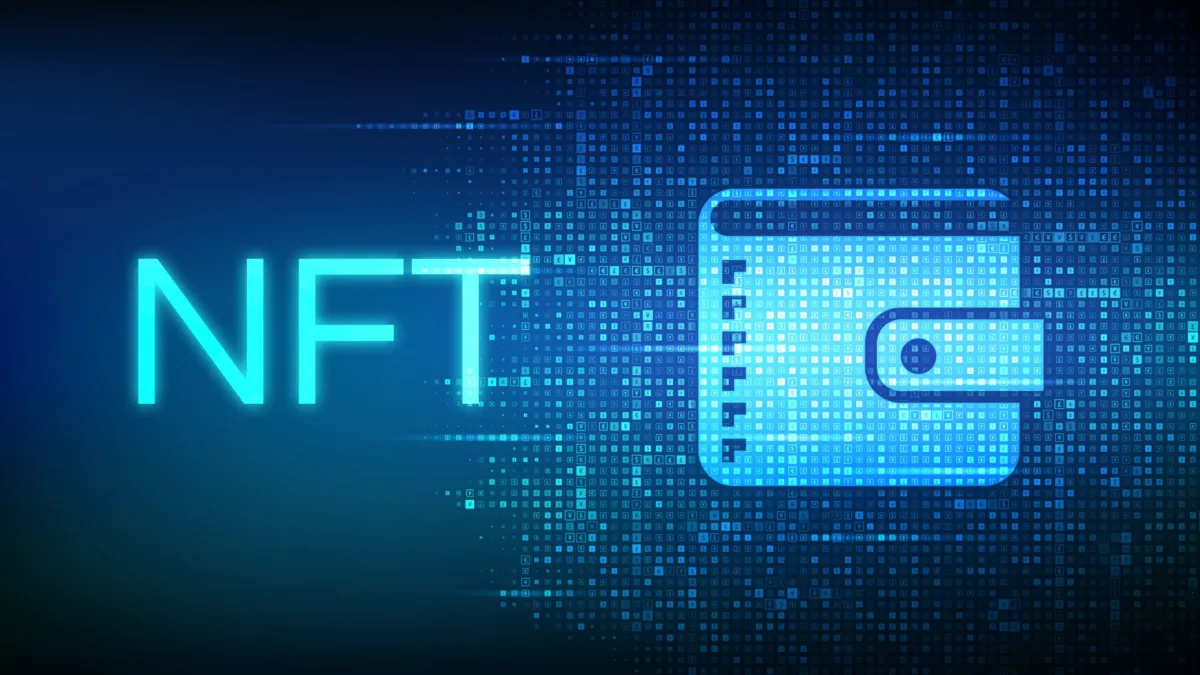Non-Fungible Tokens or NFTs are digital certificates, supported by the same technology as cryptocurrencies: the blockchain.
Since the beginning of the Internet, digital assets have always existed, such as domain names. NFTs are unique types of assets, sometimes rare and scarce. For this reason, they have value. What if there was a certificate of ownership or authenticity for these assets? What if this certificate could be traded? Thanks to NFTs, all this is possible.
To understand the concept of a Non-Fungible Token (NFT), we first need to understand what a token is.
A token is a digital record, a kind of contract or key that certifies that you have ownership of some item. It is proof of intellectual property that allows you to prove at any time that you own some asset.
And how does this work in real life? In the physical world, there has always been a difference between fungible and non-fungible items.
A fungible item is one that is not unique and can be exchanged at any time. A good example is a money.
It doesn’t matter if you have a $5 bill or a $100 bill, what matters is the value of it. Since it is a fungible and non-exclusive item, you can easily exchange this bill for another one of the same value at any time.
The non-fungible item, however, is unique and cannot be replaced. In the physical world there are also some examples, such as a t-shirt signed by a famous player, an original painting by Pablo Picasso, or a collection of baseball cards.
Suppose you have an original vinyl record that is part of a collection. This item has a serial number, so no two records in the world are alike. This record would be a non-fungible item. And at any time, because of the exclusivity feature, the owner can put a price on it.
But how does this work in the digital world? The difference is that these non-fungible items can exist only on the Internet and can also be unique. In other words, even if there are several copies, they will never be the original.
For example, recently Twitter CEO Jack Dorsey sold his first tweet for just over $2.9 million as an NFT. The message, “just setting up my Twitter,” was Dorsey’s first post on the social network, on March 21, 2006.
Through these tokens, virtual property certificates, or simply non-fungible “tokens”, the authenticity or ownership rights of any digital asset can be stored in a ledger, and the information cannot be falsified or replaced by other information.

They are called non-fungible tokens because they represent rights to assets that have these characteristics.
Not all NFTs are the same, i.e. no one NFT is the same as another, either in value or in the properties of the token itself. Each token has a digital hash (cryptographic phrase) that is different from all other tokens of its type. This allows NFTs to be like a proof of origin, something similar to the RAW file in photography. Through the NFT token you can also see the entire transaction history behind that artwork, which cannot be erased or modified, i.e. you can see who the previous and current owners of that digital artwork were.
How do NFTs work?
NFTs use the same technology as cryptocurrencies, namely the blockchain. Their transactions are performed in a digital ledger on a decentralized network and stored in a wallet.
However, an NFT is registered in a digital ledger. However, they differ from cryptocurrencies because each of these non-fungible tokens is composed of a series of metadata that provide unique properties. That is, they are individual and different from each other. The metadata can be characteristics such as size, creator name, etc.
As with cryptocurrencies, NFTs cannot be counterfeited. The registration is in a shared book, which is maintained by thousands of users around the world. The metadata of a non-fungible token guarantees the authenticity of the work.
The operation of NFTs can vary depending on the blockchain platform that supports them. In the early days, the transactions of these non-fungible assets were executed on the Ethereum network.
One of the key features of Ethereum is that it allows the creation of smart contracts (on which the standards for “tokenizing” or creating a non-fungible token are based). NFTs are ready to run on any blockchain, not just the Ethereum blockchain. Although most projects are run on this platform, it is not the only one.
In short, thanks to blockchain technology, any digital asset can become an NFT. This process is called “minting” or “tokenization”.
In what segments can NFTs be used?
A GIF file, a social media post, a digital image, an e-book, etc. All these digital items are available to anyone with just one click. However, the ownership of these creations belongs to one person, and the certificate that proves the property and its originality can be digital; and, if someone buys this digital certificate, they assume the ownership of that creation.
NFTs provide a real revolution in the digital world for artists, celebrities, big brands, influencers, and anyone who has some kind of digital right can exploit it through these digital property certificates.
These are some of the sectors in which they can be used:
- Digital art:
any digital artist can generate an information product and sell their property through NFTs.
- collectible assets or digital collectibles:
Non-fungible tokens can be issued for collection. This segment generates followers (people who have the hobby of collecting) and encourages interaction among collectors.NTFs exist on (digital) soccer player cards or even trading cards.
- Video games:
card and role-playing games, strategy games, etc. An example would be the objects acquired in role-playing games. Some of these are hard to find and have a high value for the players. These types of games often have a parallel market for the sale of such objects.
Esports:
The assets and copyrights that big figures from the world of sports or soccer clubs own can be the subject of NFT creation. For example, the NBA, the professional basketball league in the United States, through the Nba Top Shot platform that allows fans to buy and sell, or trade digital collections of or trade digital collections of videos of the best shots of all time.
- Among others:
such as domain names or any other specific rights of the owners.
It is important to note that NFTs are not in conflict with the physical world. That is, they can be a digital complement to any existing asset in the real world.
Is it worth investing in NFT?
NFTs pass on ownership of the work to the buyer only, but the creators retain copyright and reproduction rights. That means you can sell an NFT photograph and still continue to use it on your Instagram or website, sell prints in your online store, and more.
How can I sell my photos and digital art as NFTs?
An NFT is a cryptographic code that uniquely represents a photo or digital work. To create an NFT token and sell an NFT photo simply follow these steps:
1) First, select a photo in your archives that you believe many people might be interested in buying.
2) After choosing the photo or digital work, you need to choose and create an NFT marketplace account to sell your image. Currently, the most popular NFT marketplaces on the market are: Opensea , Rarible, SuperRare and Nifty Gateway. Some platforms allow any user to create and sell NFTs, but others require you to go through an application process that may or may not be approved.
After selecting a marketplace, you need to link a compatible cryptocurrency digital wallet, usually the platforms are using Ethereum, meaning the sale is not done in fiat currencies like dollar or euro, NFT tokens are traded with cryptocurrencies like Ethereum, Monero, among others. But, after selling the NFTs you can convert them into fiat currencies normally.
3) After creating the NFT photo on one of the platforms, you need to define how many issues you want to sell – it doesn’t have to be just a single issue! It can be a series. But of course, selling more than one NFT of the same photo reduces the price of the work.
4) Selling an NFT photo or work works like an auction. So, you need to set a reserve bid, i.e. the minimum amount for which you would accept to sell your NFT photo.
5) The next step is to define how much money you will receive if your work of photography is sold, by defining a royalty percentage.
6) And finally, to complete the process, you need to “Mint” your NFT photograph, making it available for sale. Minting is when your NFT certificate is created and placed on the blockchain making your artwork unique, non-fungible, as it cannot be replaced or duplicated.
With so many new terms, it seems complicated to work with NFT photography, but everything we have done for the first time requires a bit of patience and gaining experience. But there is no doubt that selling NFT photographs will soon be as popular and common in the market as selling traditional printed photos. So for those who start earlier to understand and use NFTs, for sure, they will have positioning advantages when the market demand explodes. I hope this text is just your first contact with the world of NFT photography and that you can study and learn more and more from it.
Can I invest in NFT technology?
Due to the traceability characteristic of NFT, a whole market has been created and attracts the attention of many investors.
Transactions in the NFT market have reached over $200 million in the first two months of 2021 alone.
There is no doubt that these numbers are enough to think that the market is booming, however, the reality is that the NFT market is still very small compared to that of cryptocurrencies. Therefore, since the NFT market is still growing it cannot yet be accurately measured. However, an antecedent indicator as would be of interest to developers: the number of ERC721 contracts (the first standard to represent non-fungible digital assets) is growing at an exponential rate.
NFTs are considered to be deposits of value and there are exchange platforms for them. For example, Opensea – one of the largest crypto marketplaces that include collectibles, gaming items, and another range of virtual items. The platform works as a trading house, like eBay or Amazon. But, the difference is that items are purchased through smart contracts.
How do you make money with NFT?
There are basically three ways to make money with NFTs. These are three business models that, according to the “NFT Yearly Report 2020”, can provide a stable and sufficient source of income to make it a full-time activity.
- Artist (i.e. digital content creator).
- Develop NFT projects
- Negotiate with NFT (invest in NFT)
Start Investing
Since these are non-consumable items, there is no organized market for investing in NFT. Something similar happens when investing in real estate or works of art.
There is no doubt that the art market can be a good source of income for those who know how to navigate it, but an organized market does not enjoy the transparency.
Traders or investors in these projects follow the general rules of all trading: buy at the low and sell at the high. But how can you determine whether an NFT project has growth potential?
In this sense, the functioning of the NFT market can be compared to that of the art or cryptocurrency market: It is difficult to extract the value from the assets . However, one can consider that even investing in NFT is even riskier than cryptocurrencies.
In fact, this market is too early to determine whether it is possible to make quick investments (short-term trading). However, if we are guided by the traditional art market, investments take time to mature. It is rare to see how a work of art appreciates in value after a few years.
Although, seeing the evolution of the market, the initial expectation may lead to an excess of demand and the assets grow quickly, possibly the waters return to their course (the market always regains sanity in the long term).
Future of NFTs and Stock market
It is possible that, as with all asset types, derivative instruments will emerge in NFTs. We are talking about trading CFDs and even financial futures on NFTs.
In principle, being able to trade with NFTs by means of new instruments can be an advantage. This is because the trader will access a market in which he does not actually buy a work of art based on non-fungible tokens, but instead performs a speculative maneuver on its price fluctuations.
Financial derivatives provide greater liquidity and ease of trading. Upward and downward price movements can be taken advantage of, thanks to the ease of taking short positions offered by these products. In addition, they are leveraged instruments (if you know how to manage the risk involved, leverage can be useful).
Meanwhile, the only market that exists is the spot market: the sale of NFT. Without the intermediation of a broker, only on NFT marketplaces.
It is convenient to follow the prices that this market dictates because it is the market that best determines asset prices, according to the sales that take place. In this way, by buying an NFT and observing its sale price, we can know if it is in line with the market price, if it rose or fell.
Besides NFT trading platforms or NFT marketplace, there may be a secondary market, such as groups, communities, or forums in which they can be sold cheaper, in larger lots, etc. It is all a matter of having contacts and trading. This form of trading is possible with some of the major NFT projects.
In short, the market can be complex. In any case, it is not totally impossible to invest in NFT if you know the keys to trading with these new digital assets.
Can you buy anything on NFT?
With the trend of the NFT craze, some interesting assets are emerging in the digital world, some curious and some unusual.
Why would anyone buy an NFT?
Until today, people bought rare and collectible photos, paintings, and stamps in physical, printed form. The idea of these buyers or collectors is to own a unique work or asset that will appreciate in value over time and to be able to resell it in the future for even greater value. The same happens with the works and photos sold by NFTs. Buyers invest their money in their art believing that it will be worth much more money in the future. But of course, this is in the investor’s view.
However, NFTs are not only an investment opportunity, they are also a great way for people to financially support the art creators they love. For example, if you have a lot of followers on your social networks, you can sell your NFT photography to your fans as a way for them to support and contribute to your work, without the interest of future profit.
Learn more about NFTs at WePlay Collectibles



